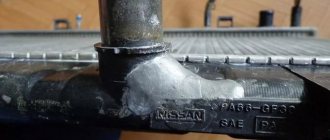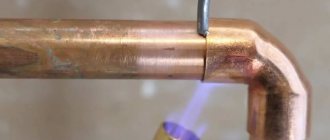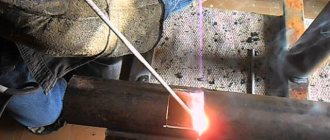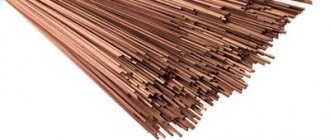Low-density polyethylene occupies a leading position in the popularity ranking among materials used for pipeline assembly. The secret of such demand is easily explained by the versatility of use and ease of installation of polyethylene pipes.
But as when working with any other polymer, high-quality installation of HDPE pipes with your own hands can only be done subject to strict adherence to technology. We will tell you what nuances to consider when joining elements. We will explain how to correctly bend and straighten them.
General information
The method of welding when connecting polyethylene pipelines is in many ways similar to the method that is widely used when installing conventional or reinforced polypropylene pipes. In the latter case, the process is often carried out using a special soldering iron, the so-called iron with nozzles.
Such a tool can be used for soldering HDPE pipelines. However, it must be taken into account that low-density polyethylene softens greatly already at a temperature of +100°C. Its value for soldering pipes made of such material depends on the wall thickness of the products. Moreover, it is smaller than that of polypropylene parts. Often its maximum value is 200-220°C.
If it is 255-265°C, then the material will simply flow. After all, it is at this temperature that most polypropylene pipelines are soldered. Although the vast majority of models of polypropylene welding machines are equipped with a temperature regulator.
Special soldering iron with temperature controller Source gi-gas.ru
On a note! Soldering HDPE pipes with a soldering iron for polypropylene can only be done for products with a small or relatively medium cross-section. After all, such heating tools are produced by manufacturers with nozzles, the diameter of which is usually 16-160mm.
Welding of large diameter polyethylene pipes is carried out using specially designed welding machines. They are bulky equipment. Therefore, homeowners do not acquire ownership of it. Usually, if it is necessary to install polyethylene pipes, they turn to specialized companies. Moreover, specialists are well aware of all the features of pipelines made of such material and the technology of their connection.
When installing external utilities, it is necessary to lay pipelines, the diameter of which can reach 300 mm or even 400 mm. When connecting such products, professionals already use special welding machines. This is expensive equipment that allows you to create reliable, high-quality connections, even when joining thick-walled pipes.
Welding machine for HDPE pipes Source pokter.ru
Compared to steel, polymers, including low-density polyethylene, have better performance characteristics. It is also worth noting that HDPE is one of the types of polymers that is well joined by welding. Therefore, for such a material there are several ways to perform welding work.
On a note! Low pressure is a plastic manufacturing method, not a material parameter. After all, high-density polyethylene is still produced. This type of material is designed for 16 or even more atmospheres.
If welding of polyethylene pipes is mentioned, then we mean soldering of HDPE. This type of plastic is often designated by the Russian abbreviation PE and even the English letters PE. For high pressure material, the options used are PEHD or HDPE.
Why is high-density PE so special?
High-density polyethylene pipe is quite rigid. The molecular bond of this product is very strong, so the manufacturing is very durable. Low pressure PE is obtained from petroleum. It is frost-resistant, does not emit harmful substances into the environment and is safe for human health. Low pressure PE is biologically inert and easy to recycle.
Depending on the purpose, a high-density PE pipeline can be:
- Food grade (for drinking water supply)
- Technical (for gas supply, sewerage, cables)
Connection methods can be detachable or permanent. By the name you can immediately determine what the difference is: detachable ones can be disassembled after soldering, one-piece ones cannot. The latter are usually used when it is necessary to work with high pressure levels.
Methods for connecting parts of a polyethylene pipeline system
The connection of PE pipes is carried out using different methods. They allow you to create permanent and detachable joints. The specific option is selected taking into account the purpose of the system and its location.
Elements of pipeline systems from HDPE for creating permanent and detachable connections Source berezka-stroi.ru
A detachable connection is created when temporary pipelines are constructed. After all, this method allows you to disassemble the system after its operation. Detachable connections of individual parts of the pipeline network can be made using steel flanges.
More often, during installation of systems, permanent connections are created. This method allows you to make joints that are highly durable. The method involves welding individual parts of pipeline networks. At the same time, butt and coupling soldering has been developed and is widely used. Each option is a reliable and effective method. Thanks to these methods, it is possible to obtain a monolithic joint between two elements of the system. Therefore, each such connection has high strength.
Method 1 - socket welding method using fittings and couplings
To implement this option for soldering polyethylene pipeline elements, a special soldering iron is used. Manufacturers make this device with a set of attachments. Their diameter corresponds to the standard sizes of HDPE pipes.
Soldering iron for socket (socket) connection Source ugra.ru
The welding process usually involves the use of fittings. These products include various angles, couplings, tees, manufactured with different standard diameters. All such parts are connecting elements. They are welded to the ends of straight pipe sections.
The design of a soldering iron for polyethylene pipes includes metal elements that heat up during operation of the device. They are the ones who heat up the HDPE products being connected.
The inner surface of the fitting is heated by a mandrel. The outer part of the PE pipe is heated by the sleeve. It is into this that a straight section of the pipeline system is inserted. The sleeve together with the mandrel are placed on the soldering iron. There are holes in the device for this purpose.
Using a special soldering iron, polyethylene pipes are often soldered inside and outside a private house. Usually specialists are invited to carry it out. After all, not every homeowner is familiar with all or at least some of the nuances of welding polyethylene pipeline elements.
Laying HDPE pipelines outside the house Source remontnik.ru
Before the welding process, a number of preparatory work is always carried out. The following operations must be carried out:
- The pipes are cut to the required length using specially designed scissors. After using them, you should get a cut that is strictly perpendicular to the axis of the product.
- The end parts of the parts to be joined are cleaned of any foreign particles.
- The ends of the system pipes that are not currently involved in the welding process are closed with plugs of a suitable size. This will allow the heated parts of the pipelines to stay cool longer and prevent contamination of their internal cavities.
- The heating surfaces of the soldering equipment are cleaned of all contaminants, including plastic particles that often remain on such parts of the device after use.
After all preparatory measures have been carried out, the HDPE pipe is soldered for water supply or communications for other purposes. However, most often the installation of polyethylene pipelines is performed when creating systems through which water from the source moves into the house.
Installation of external water supply from HDPE pipes Source wixstatic.com
See also: Catalog of construction companies that have their own production of materials and components for the construction of houses
The soldering process itself is carried out as follows:
- Parts of soldering equipment are heated to the required temperature value. The required degree of heating is determined by a special indicator on the device. An audible alarm may sound when the set temperature is reached.
- The straight section is placed in the sleeve. Its insertion is carried out until it stops. In this case, the fitting is also completely put on the heated mandrel. Most often, some effort is required to connect pipeline parts and equipment elements.
On a note! When the pipe is inserted into a heated nozzle, a roll of molten polyethylene forms on it. The material is extruded directly by the hot sleeve.
- The heated fitting is placed on the heated pipe. In this case, the two parts are connected to the annular bead, which formed on the straight element during its heating. It is a kind of guideline that allows you to avoid squeezing the connection. Otherwise, the flow area of the utility line at the junction of two parts may decrease.
The process of heating and connecting a fitting to a pipe Source alexmafuer.com
At the end of the entire process, wait until the connection cools down. During this period, ensure complete immobility of the joint. It is in this sequence that the correct welding of PE pipes using the socket method is carried out.
There is no need to put in much effort when implementing this method. However, during sleeve welding, specialists always take into account the standard heating periods of parts. The heating time of pipes and fittings depends on their diameter. The duration is also affected by the wall thickness of polyethylene products.
In addition, the two parts being connected are never squeezed. The reason for this is not only the possibility of narrowing the cross-section of the communication, but also reducing the strength of the joint.
On a note! To prevent the pipe from being crushed during its insertion into a heated sleeve, the depth of the free space in the fitting is marked on it in advance.
Before heating and joining pipes, it is recommended to mark the depth of the connection on them. Source gadgethacks.com
Method 2 - butt welding
When implementing this method, a special welding machine is used to weld polyethylene pipes. The method itself is used to connect parts made exclusively from low-density polyethylene. This is a universal method because this option allows you to maintain the flexibility of the entire pipeline system, regardless of its length. In this case, installation of utility lines made of polyethylene can be carried out in the ground or on its surface.
Butt welding of HDPE pipes is a rather complex process from a technological point of view. It must be performed by an experienced craftsman. Docking using this method is carried out in stages and strictly in a specific sequence:
- The ends of the pipes are placed in a centralizer of special welding equipment.
- Pipeline products are first aligned and then securely fixed in the welding machine.
- Dirt, grease particles, dust and other foreign debris, including various deposits, are removed from the connected ends of the pipes. Cleaning is done using cotton material, which is pre-moistened with alcohol.
Before making butt joints, all dirt is removed from the ends of HDPE pipes Source gazplast.ru
- The ends of the joined products are processed with a trimmer, which is a special device designed to remove a small layer of polyethylene. The device is used until uniform chips appear, the thickness of which should be no more than 0.5 mm.
- The treated parts of the pipeline system are removed from special equipment to check the parallelism of their ends. This process is carried out by eye and hand after connecting two parts. If a significant gap is detected between the pipes, then the end surfaces are re-aligned using a special device.
- The ends of the trimmed workpieces are heated by a heating element of welding equipment specially designed for this purpose. The surface of this part of the device is distinguished by the presence of a non-stick layer.
- PE pipes are butt welded as soon as their ends begin to melt slightly upon contact with the heating element, which is immediately removed. After this, the ends are closed.
Butt welding of polyethylene pipeline Source 2gis.com
Important! The pressure with which the two pipes are pressed against each other must be increased until a strong connection is formed. After this, the two parts of the piping system to be joined are left motionless for at least 5 minutes so that the seam between them is completely hardened.
- The quality of the created connection is checked by visual inspection. The alignment of joined pipes is assessed. In this case, the strength of the weld must be checked.
Important! Before soldering HDPE pipes, preparatory work is always carried out. They are carried out with special care, because the reliability and strength characteristics of the joint being performed will depend on their quality.
Effective methods of joining HDPE pipes
Technologically, HDPE pipes can be connected using two main methods – one-piece and detachable.
The first involves the use of a welding machine, the second is implemented without using one.
Each fastening method has its own advantages and disadvantages, and therefore the optimal option for joining polymer pipes is chosen based on specific conditions
Welded permanent connections enable maximum sealing, which is especially important when constructing pressure lines. Detachable connections are easy to install and make it possible to disassemble the pipeline at any time in order to change the configuration of the main line or add new bends to it.
Video description
This video will help you clearly understand the process of connecting polyethylene pipes using butt welding:
Method 3 – electrofusion welding option
This method differs from the method when soldering HDPE pipes with a soldering iron. This option involves the use of electric couplings rather than simple fittings. The method is specially designed for connecting straight sections of a polyethylene pipeline system.
An electric coupling is a special fitting. It has embedded heating elements in its design. Manufacturers also produce connecting elements in the form of tees and other designs, each of which is equipped with spirals for strong heating of polyethylene.
On a note! The plastic from which the coupling is made heats up greatly and even expands, which allows it to connect with the polymer of the pipe. The result is a structure with a monolithic structure.
Electric couplings are quite expensive fittings. The cost of such parts for pipelines can be 100,000 rubles. or even more if the system has a significant diameter. This statement is relevant for fittings whose cross-sectional size exceeds 600 mm. However, soldering of large-diameter HDPE pipes is rarely performed on the territory of a private house.
Polyethylene electrocoupling Source agruamerica.com
A significant advantage of using electric couplings is the absence of burr, which is formed when soldering is performed by other methods. Therefore, the utility communication capacity does not decrease.
On a note! Burr is molten polyethylene, which, after connecting two parts of the pipeline system, hardens and forms streaks. From the outside they can be removed quite easily, but inside the pipes it is difficult or even impossible to get rid of them. Leaks can cause a decrease in communication throughput.
Polyethylene pipes are connected by welding and using an electric coupling in the following sequence:
- A piece of pipe of the required length is prepared, which will be connected to the polyethylene communication.
- The welded areas on the pipes and in the electric coupling are cleaned of debris and dirt, and also cleaned to remove the oxidized layer.
- Places are marked on the pipes to be connected that allow you to control the depth during their insertion into the electric coupling.
- The open ends of the piping system are sealed with plugs to prevent rapid cooling of the welding site.
- The parts are connected into a single unit.
Assembling a unit from two HDPE pipes and an electric coupling Source veld-plast.ru
- The welding machine is connected by two wires to the electric coupling.
- The welding process is started by pressing a special button on the equipment.
- Wait until welding is complete. It depends on the size of the parts being connected.
On a note! After the allotted time has elapsed, most models automatically turn off.
Upon completion of the welding process, the heated and molten polyethylene will harden for at least 1 hour. Only after this time will the material gain strength and the pipeline can be used for its intended purpose.
Special equipment
Forethought is required when selecting equipment
It is important to consider the complexity of the work. To cope with large volumes of films, industrial equipment is used. https://www.youtube.com/embed/WPizsSZjyCo
Special devices are used to join polyethylene. Their prices vary. It is worth noting the budget model PP-40.
It allows you to get an even and durable seam on any contour: straight or complex. PP-40 is shaped like a soldering iron, but has a different tip.
They also use special attachments for electric irons. They are made from sheet metal, such as aluminum. The base of the nozzles is made flat and ribbed. This surface firmly fixes the film joint during welding.
The edges of the film are secured with ribs. Then move the strip along the area to be welded. This creates a double seam.
Large jobs require the use of more serious tools. To create a large-area film joint, you will need special welding equipment.
Such equipment is equipped with settings for the level of pressure, temperature, and the speed of movement of the heated element along the surface of the polyethylene. In household options for forming film seams, there are no such functions.
In addition to setting regulators, soldering machines are equipped with roller mechanisms. These are setting and tension elements that stabilize the speed of advance of the film sheets being welded.
This improves the quality of polyethylene soldering and increases the strength of the connection.
There are devices that use different heating methods: air and contact. Air heating is produced by exposing the material to hot air. Contact involves a heating element in contact with the material.
Selecting a welding method
The working conditions influence the method of soldering when connecting individual elements of polyethylene pipeline systems. The appropriate option is selected taking into account the pros and cons of a particular method. Other factors that are of considerable importance are also taken into account.
So, if it is necessary to create the most flexible pipeline system, polyethylene pipes are butt welded. This option will eliminate the formation of individual hard sections. This method is also economical and simplest to implement.
The electrofusion method is the most expensive method. It is well suited for hard-to-reach areas where space around the pipeline is very limited. Another advantage of this option is its high technology. It provides the required connection quality, which never has to be redone.
Electrofusion welding option Source smartsk.ru
On a note! In many summer cottages, detachable connections of HDPE pipes are performed. This option for joining polyethylene products is used if, for example, a temporary system for watering certain beds is created. This method is also used when you need to quickly complete a one-time job.
The socket welding method, when simple couplings or other fittings are additionally used to branch the system, is suitable for cases where it is necessary to connect individual communication elements in hard-to-reach places. In these areas it will be impossible to implement the butt method. In many cases, special equipment will not even fit in such places. In addition, at these points in the system it is almost always impossible to perform axial displacement of the parts being welded. Therefore, the only option is to use a special soldering iron.
Butt
(butt welding of polyethylene gas pipelines is carried out using highly automated machines from the French company J.Sauron SA)
DiameterPrice per joint Minimum cost of work performed during one work shift 18,000 rubles Rental cost of a 6kVA/1phase/220V generator 4000 rubles/shift 63,600 rubles 75,660 rubles 90,900 rubles 1,101,100 rubles 1,251,450 rubles 1,401,600 rubles 1,601,800 rubles 1,802,450 rubles 2002750 rub. RUB 2,253,000 Minimum cost of work performed per work shift RUB 22,000 RUB 2,503,750 RUB 2,804,300 RUB 3,155,000 RUB 3,556,000 Minimum cost of work performed per work shift RUB 28,000 Rental cost of a 12kVA/3phase/380V generator RUB 6,000/shift 400,720 0 rub. 4508300 rub.50010000 rub.Briefly about the main thing
Welding polyethylene when connecting individual elements of pipeline systems can be performed using a soldering iron for polypropylene. However, it is used for joining small diameter pipes. It is often even used in non-critical areas.
Higher quality welding is performed with equipment that allows pipes to be joined end-to-end. They are placed in a centralizer, aligned, secured, heated and joined under pressure.
An even more high-tech method is the use of electrofusion couplings. They are distinguished by the presence of built-in heating elements that melt polyethylene after connecting to the equipment.
Regardless of the method, the parts being connected, piping systems are first cleaned of any dirt. If necessary, their ends are cut strictly perpendicular to the longitudinal axis.
Ratings 0
Electrofusion
DiameterPrice per jointMinimum cost of work performed during one work shift is 18,000 rubles. Rental cost of a 6kVA/1phase/220V generator 4000 RUR/shift 63500 RUR 75550 RUR 90650 RUR 110900 RUR 1251200 RUR 1401350 RUR 1601550 RUR 1802000 RUR 2002300 RUR 2252500 RUR 2503300 RUR 2803 700 rub. 3154400 rub. RUB 3,555,500. Minimum cost of work performed in one work shift: RUB 24,000. RUB 4,006,600. RUB 4,507,700. RUB 5,009,300.Quality control - we check the result of the work
This procedure is carried out after completion of all work and is intended to identify the presence of possible defects that could arise during the installation of the pipeline. It should be noted that such a concept as a defect includes inhomogeneities of micro and macro types. These “troubles” can arise as a result of violations of welding and assembly technology.
Defects are divided into two types:
Also, it is necessary to note such types of defects as destructive and non-destructive - they arise in the process of exposure of the welded joint to polyethylene.
The quality check itself is carried out by laboratories, express methods, and special organizations that have a certificate from an industry testing center (conduct in-depth research). If the pipeline was laid by a master at home, then it is enough to check the seams for leaks - a test run of water is carried out and the system is monitored for 2-3 days.











